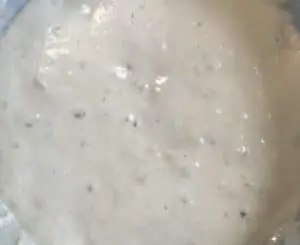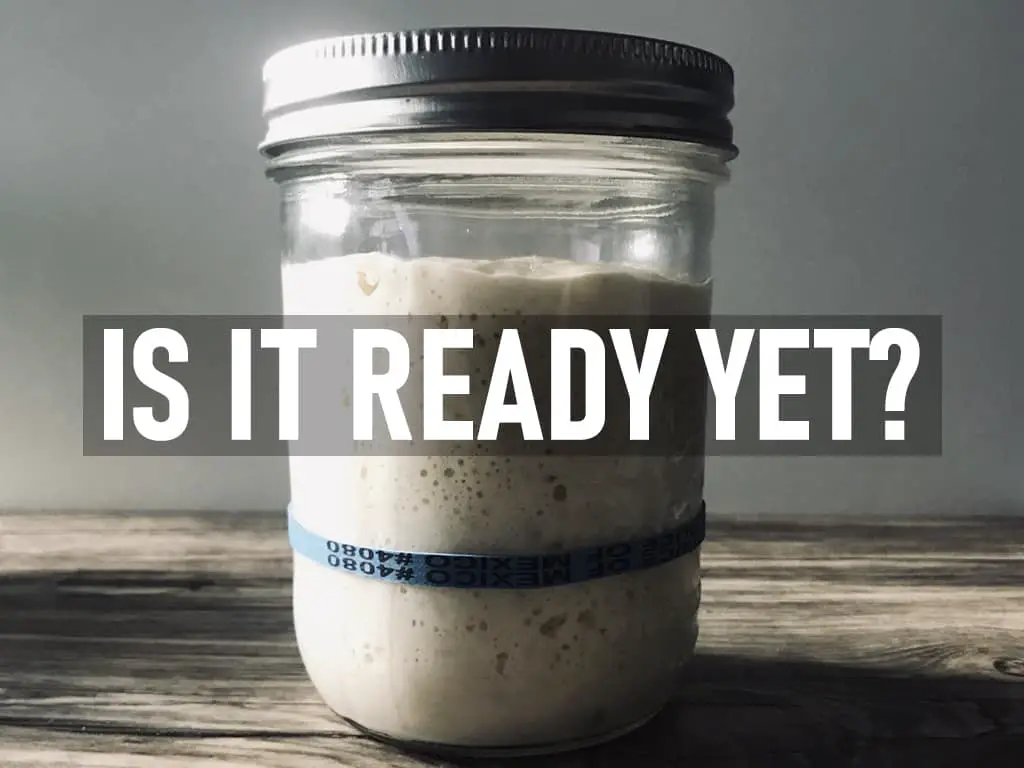This is a fairly common question we hear around here, and ironically we’ve actually found that it is two questions in one package. Either you’re wanting to know when you can use your new starter, the one that you just started from scratch a few days ago, or you are asking when you can use an established starter after it has been fed. We’ll answer both here, and if you have another issue or question in mind feel free to drop that in the comments below.
When is My New Sourdough Starter Ready to Use?
A typical new starter will be ready to use somewhere between days 7 to 14 after its first feeding. If you follow our recipe it will most generally be ready by day 7. Look for a bubbly rise that increases close to three times its volume over a 6-8 hour window. It is important to see this consistent rise for a couple of days in a row.
Additionally, you’re looking for a pleasant sour yet sweet odor. Something similar to cheap white wine.
When is my Mature Starter Ready to Use After Feeding?
Waiting 6-8 hours after feeding a mature starter and leaving out at room temperature is a common practice before using it in a recipe. A starter should have doubled or tripled in volume while showing bubbly activity.
There are a few caveats to consider like room temperature, how often your starter is fed, and the amount of starter in comparison to the amount of flour and water it was fed. But, generally speaking, 6-8 hours, at least a doubling of size, and bubbly activity should be enough reason to assume your starter is ready. Additionally, you can try the float test, which involves putting a little bit of your starter in a bowl of water. If the bit of starter floats it is said to be ready. If it sinks it needs more time. If your starter collapsed and doesn’t float it has gone too long. Please note that the float test is not perfect, don’t try it until you see all of the other signs.
More on Starting a Starter From Scratch
If you are starting a starter from scratch, our first suggestion would be to follow the recipe as closely as you can. If the recipe says it should be ready, follow that advice. There are so many variables and options out there, that it is impossible to give a blanket statement for all. But, the general guidelines we mentioned above and below, should work to bolster the info found in your recipe.
Also, please note that we are not giving out health advice, and do not pretend to know if a food product is safe or not. Sorry if that is the question you are asking, that would be impossible for us simple home bakers to attempt to answer for you, especially over the internet. But, what we are referring to is when it has the right amount of leavening power to properly leaven bread.
What we look for in a new starter is consistency in the daily rise and fall. The recipe we use takes about 5 days before we start to see a doubling to tripling in size over a 6-8 hour window. Then over days 6 and 7, it repeats the process while we increase the amount of each feeding. If the starter can handle the increased size in feeding, and keep doubling in size over the course of 6-8 hours all signs point to an active starter. This is why we typically use ours on day 7, or if we started it at night, we feed it before bed and bake with it on the morning of day 8.
If it lags, and isn’t consistent, just keep up the routine of feeding until it becomes consistent for two to three days.
For added peace of mind, do a little “test” to ensure it is good to go, but only if you really want to be sure. It certainly isn’t needed, but can be reassuring. To do the test, just take a small amount of your discard portion, around 20-30 grams, and add it to 100 grams water and 100 grams flour. If it blows through that and doubles by the end of the day, it’s certainly got the power to leaven bread.
More on Established Starters Post Feeding

This one has a few caveats, but it is a pretty simple answer. It really comes down to activity, and ways to gauge activity. I used to be a 6th-grade teacher and one of my favorite things to teach my students was how to cross-reference information to test facts vs truth claims. We would look for information that was repeated in multiple sources to build confidence, and we would look for signs that the sources were known for being trustworthy. In a stretch of sorts, that principle of building confidence applies in a strange way with starters. We are simply building evidence that the starter is likely ready, by looking for a few key things. Like as if we were building evidence for an article being trustworthy.
For starters, you want to “cross-reference” with your past attempts and other people’s experiences. Time and amounts used being the key things to look for and compare. This means you’re looking for the starter to water and flour ratio, and how long it takes to get active.
So look around at a few different recipes online to find the ratio they are using, and how long they say it takes to become ripe. From there you can piece together a range for yourself.
For us, based on our own experience over a couple of years of tracking and looking at other recipes, we got to the 6-8 hour mark whenever we feed our starter straight from the fridge and leaving out on the counter to become active. That time is consistently right when use between 50 to 100 grams of our starter to 100 grams of flour and 100 grams water.
The closer we are to 50 grams starter to 100 grams flour and water, the closer to 8 hours it takes at room temp to become active enough. The other end is true as well. The closer we are to 100 grams starter to 100 grams flour and water, the closer to 6 hours we get.
Once you have the time frame down, that is the first bit of evidence you are looking for. If enough people say that time frame with that amount of feeding works for them, it likely will translate to your home as well. However, you still want to see a few other signs to build confidence.
Is it bubbly? Has it risen two to three times in volume? Within your time frame? Then yes, it should be trusted to be ready. On the other hand, if it goes too long and starts to fall, you want to catch it before dropping too far. If it goes down by a quarter it is likely less active then you want. Unless your recipe specifically says let if fall before using.
THE CAVEATS
All the above can be thrown out the window, at least for one feeding, if you have not fed your starter for a few days (if stored on the counter) or for over a week (if stored in fridge). If that is the case, then you’ll need to feed it, let it go through the rise and fall process and feed it one more time. Don’t trust a starter that hasn’t been fed for a few days at room temp or over a week at fridge temps. Once you feed it a second time, go back to the above mentioned tests.
If your house stays cold, it could likely take much longer to double in size. If that is the case, then you might want to find ways to keep your starter at the optimal room temp for starter growth at around 78°F. Some regularly used options we see and/or use ourselves are using a microwave as a proofing box. Don’t turn it on, but simply place it in there, they are good at keeping warmth in. The same goes for an oven, but generally, the smaller size of the microwave works best. You can also place a warm rag over the jar, replacing it throughout the day. Or go big and get an actual proofing box! We’ve not gone there yet, but if you do, let us know just how glorious it is. We’ll live vicariously through you. 🙂


